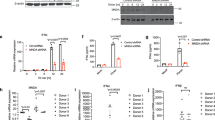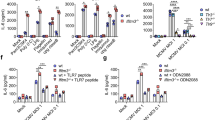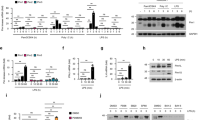Abstract
Infection of macrophage lineage cells is a feature of primate lentivirus replication, and several properties of primate lentiviruses seem to have evolved to promote the infection of macrophages. Here we demonstrate that the accessory gene product Nef induces the production of two CC-chemokines, macrophage inflammatory proteins 1α and 1β, by HIV-1-infected macrophages. Adenovirus-mediated expression of Nef in primary macrophages was sufficient for chemokine induction. Supernatants from Nef-expressing macrophages induced both the chemotaxis and activation of resting T lymphocytes, permitting productive HIV-1 infection. These results indicate a role for Nef in lymphocyte recruitment and activation at sites of virus replication.
This is a preview of subscription content, access via your institution
Access options
Subscribe to this journal
Receive 12 print issues and online access
$209.00 per year
only $17.42 per issue
Buy this article
- Purchase on Springer Link
- Instant access to full article PDF
Prices may be subject to local taxes which are calculated during checkout





Similar content being viewed by others
References
Gartner, S. et al. The role of mononuclear phagocytes in HTLV-III/LAV infection. Science 233, 215–219 (1986).
Wiley, C.A., Schrier, R.D., Nelson, J.A., Lampert, P.W. & Oldstone, M.B.A. Cellular localization of human immunodeficiency virus infection within the brains of acquired immune deficiency syndrome patients. Proc. Natl. Acad. Sci. USA 83, 7089–7093 (1986).
Koenig, S. et al. Detection of AIDS virus in macrophages in brain tissue from AIDS patients with encephalopathy. Science 233, 1089–1093 (1986).
Orenstein, J.M., Fox, C. & Wahl, S.M. Macrophages as a source of HIV during opportunistic infections. Science 276, 1857–1861 ( 1997).
Veazey, R.S. et al. The gastrointestinal tract as a major site of CD4+ T cell depletion and viral replication in SIV infection. Science 280, 427–431 (1998).
Alkhatib, G. et al. CC CKR5: a RANTES, MIP-1α, MIP-1β receptor as a fusion cofactor for macrophage-tropic HIV-1. Science 272, 1955–1958 (1996).
Deng, H. et al. Identification of a major co-receptor for primary isolates of HIV-1. Nature 381, 661–666 (1996).
Choe, H. et al. The β-chemokine receptors CCR3 and CCR5 facilitate infection by primary HIV-1 isolates. Cell 85, 1135 –1148 (1996).
Dragic, T. et al. HIV-1 entry into CD4+ cells is mediated by the chemokine receptor CC-CKR-5. Nature 381, 667–673 (1996).
Doranz, B.J. et al. A dual-tropic primary HIV-1 isolate that uses fusin and the βchemokine receptors CKR-5, CKR-3, and CKR-2b as fusion cofactors. Cell 85, 1149–1158 (1996).
Liu, R. et al. Homozygous defect in HIV-1 coreceptor accounts for resistance of some multiply-exposed individuals to HIV-1 infection. Cell 86, 367–377 (1996).
Wu, L. et al. CCR5 levels and expression pattern correlate with infectability by macrophage-tropic HIV-1, in vitro. J. Exp. Med. 185, 1681–1691 (1997).
Wolfs, T.F.W., Zwart, G., Bakker, M. & Goudsmit, J. HIV-1 genomic RNA diversification following sexual and parenteral virus transmission. Virology 189, 103–110 ( 1992).
Keet, I.P.M. et al. Predictors of rapid progression to AIDS in HIV-1 seroconverters. AIDS 7, 51–57 (1993).
Zhu, T. et al. Genotypic and phenotypic characterization of HIV-1 in patients with primary infection. Science 261, 1179– 1181 (1993).
Lewis, P.F. & Emerman, M. Passage through mitosis is required for oncoretroviruses but not for the human immunodeficiency virus. J. Virol. 68, 510–516 ( 1994).
Roe, T., Reynolds, T.C., Yu, G. & Brown, P.O. Integration of murine leukemia virus DNA depends on mitosis. EMBO J. 12, 2099–2108 (1993).
Weinberg, J.B., Matthews, T.J., Cullen, B.R. & Malim, M.H. Productive human immunodeficiency virus type 1 (HIV-1) infection of nonproliferating human monocytes. J. Exp. Med. 174, 1477– 1482 (1991).
Heinzinger, N. et al. The Vpr protein of human immunodeficiency virus type 1 influences nuclear localization of viral nucleic acids in nondividing host cells. Proc. Natl. Acad. Sci. USA 91, 7311– 7315 (1994).
Fletcher, T.M. et al. Nuclear import and cell cycle arrest functions of the HIV-1 Vpr protein are encoded by two separate genes in HIV-2/SIMSM. EMBO J. 15, 6155–6165 ( 1996).
Gallay, P., Hope, T., Chin, D. & Trono, D. HIV-1 infection of nondividing cells through the recognition of integrase by the importin/karyopherin pathway. Proc. Natl. Acad. Sci. USA 94, 9825–9830 (1997).
Vodicka, M.A., Koepp, D.M., Silver, P.A. & Emerman, M. HIV-1 Vpr interacts with the nuclear transport pathway to promote macrophage infection. Genes Dev. 12, 175– 185 (1998).
Hirsch, V.M. et al. Vpx is required for dissemination and pathogenesis of SIV SM PBj: evidence of macrophage-dependent viral amplification. Nature Med. 4, 1401–1408 (1998).
Gruber, M.F., Weih, K.A., Boone, E.J., Smith, P.D. & Clouse, K.A. Endogenous macrophage CSF production is associated with viral replication in HIV-1-infected human monocyte-derived macrophages. J. Immunol. 154, 5528– 5535 (1995).
Naldini, L. et al. In vivo gene delivery and stable transduction of nondividing cells by a lentiviral vector. Science 272, 263–267 (1996).
van Kooten, C. & Banchereau, J. Functions of CD40 on B cells, dendritic cells and other cells. Curr. Opin. Immunol. 9, 330–337 ( 1997).
Alderson, M.R. et al. CD40 expression by human monocytes: regulation by cytokines and activation of monocytes by the ligand for CD40. J. Exp. Med. 178, 669–674 ( 1993).
Zack, J.A. The role of the cell cycle in HIV-1 infection. Adv. Exp. Med. Biol. 374, 27–31 ( 1995).
Sasseville, V.G. et al. Chemokine expression in simian immunodeficiency virus-induced AIDS encephalitis. Am. J. Pathol. 149, 1459 –1467 (1996).
Kestler III, H.W. et al. Importance of the nef gene for maintenance of high virus loads and for development of AIDS. Cell 65, 651–662 (1991).
Deacon, N.J. et al. Genomic structure of an attenuated quasi species of HIV-1 from a blood transfusion donor and recipients. Science 270, 988–991 (1995).
Kirchhoff, F., Greenough, T.C., Brettler, D.B., Sullivan, J.L. & Desrosiers, R.C. Brief report: absence of intact nef sequences in a long-term survivor with nonprogressive HIV-1 infection. N. Engl. J. Med. 332, 228– 232 (1995).
Garcia, J.V. & Miller, A.D. Serine phosphorylation independent downregulation of cell-surface CD4 by Nef. Nature 350 , 508–511 (1991).
Collins, K.L., Chen, B.K., Kalams, S.A., Walker, B.D. & Baltimore, D. HIV-1 Nef protein protects infected primary cells against killing by cytotoxic T lymphocytes. Nature 391, 397–401 (1998).
Stevenson, M. Pathway to understanding AIDS. Nature Struct. Biol. 3, 303–306 (1996).
Dairaghi, D.J. et al. Macrophage inflammatory protein-1beta induces migration and activation of human thymocytes. Blood 91, 2905–2913 (1998).
Neote, K., DiGregorio, D., Mak, J.Y., Horuk, R. & Schall, T.J. Molecular cloning, functional expression, and signaling characteristics of a C-C chemokine receptor. Cell 72, 415–425 ( 1993).
Taub, D.D., Conlon, K., Lloyd, A.R., Oppenheim, J.J. & Kelvin, D.J. Preferential migration of activated CD4+ and CD8+ T cells in response to MIP-1 alpha and MIP-1 beta. Science 260, 355–358 (1993).
Ullum, H. et al. Production of β-chemokines in human immunodeficiency virus (HIV) infection: Evidence that high levels of macrophage inflammatory protein-1β are associated with a decreased risk of HIV disease progression. J. Infect. Dis. 177, 331–336 (1998).
Esser, R., Glienke, W., von Briesen, H., Rubsamen-Waigmann, H. & Andreesen, R. Differential regulation of proinflammatory and hematopoietic cytokines in human macrophages after infection with human immunodeficiency virus. Blood 88, 3474–3481 (1996).
Zou, W. et al. Early cytokine and chemokine gene expression in lymph nodes of macaques infected with simian immunodeficiency virus is predictive of disease outcome and vaccine efficacy. J. Virol. 71, 1227 –1236 (1997).
Schmidtmayerova, H. et al. Human immunodeficiency virus type 1 infection alters chemokine β peptide expression in human monocytes: implications for recruitment of leukocytes into brain and lymph nodes. Proc. Natl. Acad. Sci. USA 93, 700–704 (1996).
Canque, B. et al. Macrophage inflammatory protein-1alpha is induced by human immunodeficiency virus infection of monocyte-derived macrophages. Blood 87, 2011–2019 ( 1996).
Cocchi, F. et al. Identification of RANTES, MIP-1α, and MIP-1β as the major HIV-suppressive factors produced by CD8+ T Cells. Science 270, 1811–1815 (1995).
Jansson, M. et al. Sensitivity to inhibition by beta-chemokines correlates with biological phenotypes of primary HIV-1 isolates. Proc. Natl. Acad. Sci. USA 93, 15382–15387 (1996).
Kalter, D.C. et al. Enhanced HIV replication in macrophage colony-stimulating factor-treated monocytes. J. Immunol. 146, 298–306 (1991).
van Kooten, C. & Banchereau, J. Immune regulation by CD40-CD40-l interactions. Front. Biosci. 2, d1–d11 (1997).
Wahl, L.M. et al. Isolation of human mononuclear cell subsets by counterflow centrifugal elutriation. Cell. Immunol. 85, 373–383 (1984).
Zhou, L.J. & Tedder, T.F. A distinct pattern of cytokine gene expression by human CD83+ blood dendritic cells. Blood 86, 3295–3301 (1995).
McKnight, A. et al. Inhibition of human immunodeficiency virus fusion by a monoclonal antibody to a coreceptor (CXCR-4) is both cell type and virus strain dependent. J. Virol. 71, 1692–1696 (1997).
McGrory, W.J., Bautista, D.S. & Graham, F.L. A simple technique for the rescue of early region I mutations into infectious human adenovirus type 5. Virology 163, 614–617 (1988).
Hitt, M., Bett, A.J., Addison, C.L., Prevec, L. & Graham, F.L. Techniques for human adenovirus vector construction and characterization. Methods Mol. Genet. 7, 13–30 (1995).
Acknowledgements
We thank E. Thomas, S. Dupont and B. Blais for technical assistance, H.E. Gendelman for assistance with macrophage culture, B. Mellor and K. Toohey for graphics support and N. Bakker for manuscript preparation. This work was supported by National Institutes of Health grants, NS30769 and NS35732 to A.L., AI39445 and HL96008 to E.J., AI37475, HL57880 and RR11589 to M.S. and by funding from the Edward Jenner Institute for Vaccine Research (M.S.).
Author information
Authors and Affiliations
Corresponding author
Rights and permissions
About this article
Cite this article
Swingler, S., Mann, A., Jacqué, JM. et al. HIV-1 Nef mediates lymphocyte chemotaxis and activation by infected macrophages. Nat Med 5, 997–1003 (1999). https://doi.org/10.1038/12433
Received:
Accepted:
Issue Date:
DOI: https://doi.org/10.1038/12433
This article is cited by
-
Protein N-myristoylation: functions and mechanisms in control of innate immunity
Cellular & Molecular Immunology (2021)
-
Coronary artery disease in patients with human immunodeficiency virus infection
Journal of Nuclear Cardiology (2021)
-
Engineering modular intracellular protein sensor-actuator devices
Nature Communications (2018)
-
Molecular characterization of HIV-1 Nef and ACOT8 interaction: insights from in silico structural predictions and in vitro functional assays
Scientific Reports (2016)
-
Understanding HIV Compartments and Reservoirs
Current HIV/AIDS Reports (2014)



